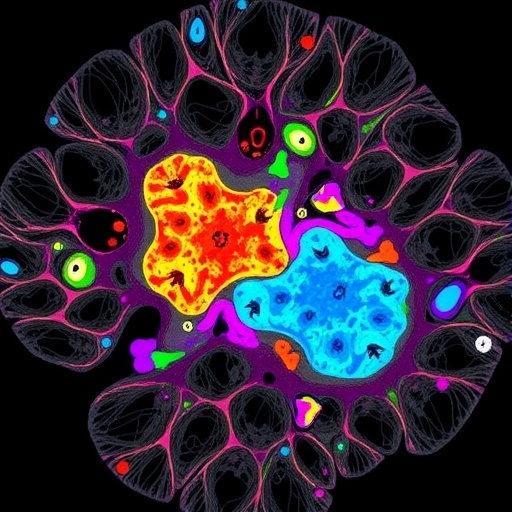In a groundbreaking development poised to advance the frontiers of spatial biology, researchers from the Icahn School of Medicine at Mount Sinai, in collaboration with Boston Medical Center and Boston University’s Chobanian & Avedisian School of Medicine, have unveiled Giotto Suite. This innovative software platform addresses the critical challenge of deciphering complex molecular landscapes in tissues with unprecedented depth and scalability. Published in the October 1, 2025, online issue of Nature Methods, Giotto Suite emerges as a transformative tool designed to navigate the intricacies of spatial omics datasets that have grown exponentially with recent technological progress.
Spatial omics, an area marking a paradigm shift in tissue analysis, enables scientists to map RNA transcripts and protein distributions within intact tissues. This multidimensional insight into cellular organization and interaction offers crucial clues to the biological architecture underpinning health and disease, fueling discoveries in oncology, neurodegeneration, and immunology. However, the vast complexity and heterogeneity intrinsic to spatial omics data have created substantial barriers to effective analysis, often requiring the use of fragmented, multi-package computational tools that impede seamless integration and interpretation.
Recognizing this bottleneck, the team led by Professors Guo-Cheng Yuan and Ruben Dries designed Giotto Suite as an all-encompassing ecosystem integrated within R, a versatile programming environment favored by biostatisticians and computational biologists. The platform’s core strength lies in its technology-agnostic approach, accommodating spatial datasets from diverse platforms regardless of scale or measurement type. This adaptability allows researchers to tailor their analytical workflow around their specific experimental setups and scientific questions, rather than being constrained by software limitations.
One of Giotto Suite’s key technical innovations is its modular architecture, which combines the end-to-end steps of a spatial omics analysis pipeline into a unified framework. From raw data preprocessing to advanced spatial visualization and integration of multi-modal data, each module is crafted to maintain interoperability yet functions cohesively to streamline complex workflows. This integration mitigates the common issue of error propagation and compatibility challenges encountered when piecing together disparate tools for spatial data analysis.
Beyond simplified data handling, Giotto Suite incorporates scalable computational algorithms designed to manage the ever-increasing size and resolution of spatial datasets. As spatial technologies progress towards single-cell and subcellular resolution with simultaneous multi-omics readouts, this scalability ensures that researchers can analyze their data without compromising speed or accuracy. Advanced spatial statistics embedded within Giotto offer novel ways to characterize cellular neighborhoods and molecular gradients, crucial for understanding tissue microenvironments.
The software’s flexible entry points represent another significant leap forward. Users can commence their analyses from varied stages: raw data inputs, partially processed datasets, or integrated multi-modal outputs. This flexibility suits a wide array of research workflows, promoting inclusivity for new users while providing customization power for experienced bioinformaticians. Giotto Suite also supports cross-platform data harmonization, enabling meta-analyses that combine datasets from different spatial omics technologies, a capability vital for large consortium studies and reproducibility efforts.
Despite its robust feature set, the creators acknowledge that the initial release encompasses only a portion of spatial analytical methodologies required by the field’s full spectrum of research queries. They emphasize Giotto Suite’s evolutionary design, inviting community contributions and user feedback. Committed to maintaining an open-source ethos, the team plans continuous expansion with enhanced interoperability to third-party tools, improved visualization capacities, and comprehensive training resources to accelerate adoption.
The development of Giotto Suite was generously supported by notable funding bodies including the Chan Zuckerberg Initiative’s Essential Open Source Software for Science Program, the Alex’s Lemonade Stand Foundation’s Crazy 8 Initiative, and several NIH grants. This broad financial backing reflects the scientific community’s recognition of spatial omics as a cornerstone of future biomedical research and the pressing need for accessible analytical infrastructure.
Looking ahead, Yuan, Dries, and their collaborators intend to directly apply Giotto Suite in their ongoing investigations into cancer biology and neurodegenerative diseases. They anticipate that the platform will expedite the identification of spatial molecular signatures and uncover new cellular phenotypes, ultimately informing targeted therapies and diagnostics. Their commitment to iterative refinement ensures that Giotto Suite will evolve in tandem with emerging spatial technologies and computational innovations.
Giotto Suite’s release marks a pivotal moment in spatial omics research—transforming abundant yet complex spatial data into actionable biological insights. As spatial resolution and multi-omic depth accelerate, tools like Giotto Suite will be indispensable, democratizing access to spatial data analytics and catalyzing breakthroughs across biomedical disciplines. The availability of this open-source platform invites a new era where scientists can seamlessly decode the spatial intricacies of life at molecular and cellular scales.
Researchers interested in exploring Giotto Suite can access the software freely through http://giottosuite.com, fostering broad engagement from the global scientific community. Such open dissemination amplifies collaborative opportunities and accelerates the collective endeavor to unravel spatial biology’s mysteries. Giotto Suite stands as a beacon of innovation, promising to reshape our understanding of tissue biology, disease mechanisms, and ultimately, human health.
Subject of Research: Human tissue samples
Article Title: Giotto Suite: a multi-scale and technology-agnostic spatial multi-omics analysis ecosystem
News Publication Date: 1-Oct-2025
Web References: http://giottosuite.com; http://dx.doi.org/10.1038/s41592-025-02817-w
References: Chen, Chávez-Fuentes, et al., Nature Methods, DOI: 10.1038/s41592-025-02817-w
Image Credits: Chen, Chávez-Fuentes, et al., Nature Methods
Keywords: Genomics




